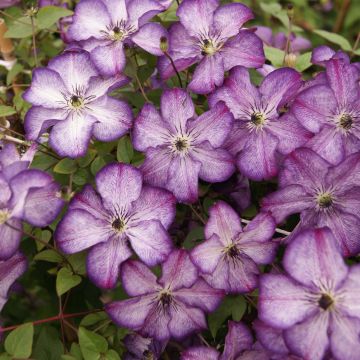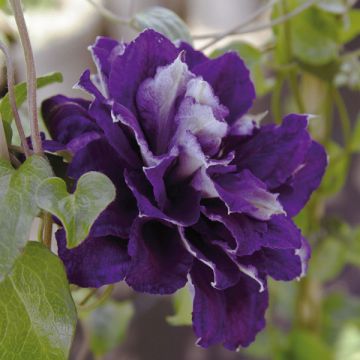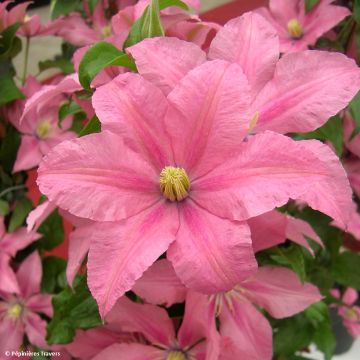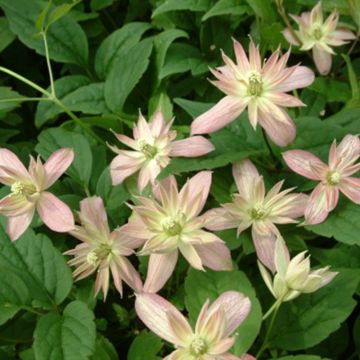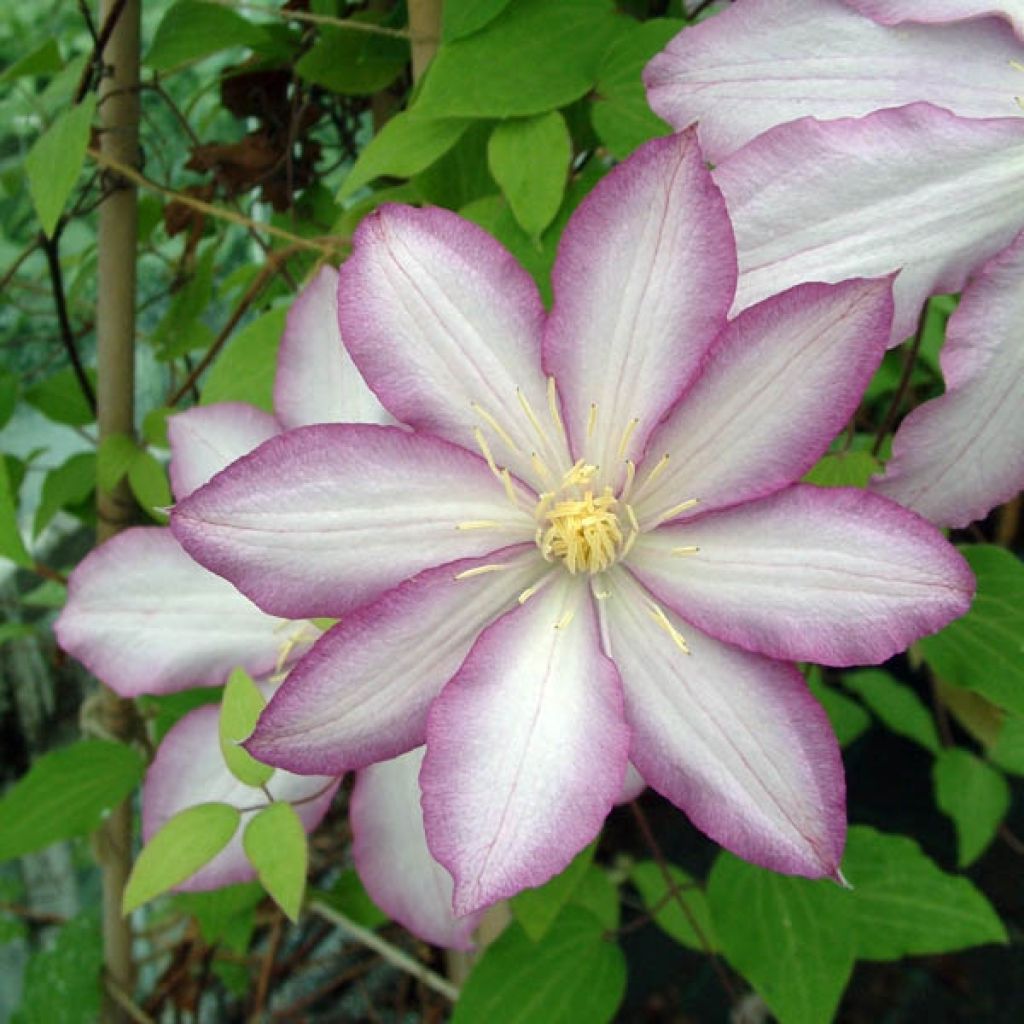

Clématite Morning Star


Clématite Morning Star
Clematis Morning Star
Clematis patens Morning Star
Early Large-flowered Clematis
Beautiful plant, good delivery, waited patiently for 3 weeks to be planted at the right temperature. It was beautiful for 3 weeks and then, in just 3 days, it dried up completely... Is it salvageable?...
Odile, 28/05/2020
This item cannot be shipped to the selected country
Delivery charge from €5.90
More information
Schedule delivery date,
and select date in basket
This plant carries a 6 months recovery warranty
More information
We guarantee the quality of our plants for a full growing cycle, and will replace at our expense any plant that fails to recover under normal climatic and planting conditions.
From €5.90 for pickup delivery and €6.90 for home delivery
Express home delivery from €8.90.
Does this plant fit my garden?
Set up your Plantfit profile →
Description
Clematis Morning Star is a recent variety of clematis with a particularly bright flowering and a modest size, well suited to small spaces and pot cultivation. It displays large single star-shaped flowers in white-pink delicately edged with deeper lilac-purple at the beginning of summer. The flowers produced throughout the summer will be smaller, but adorned with the same brilliance. Combine this lovely climbing plant with blue or pink varieties to form very romantic garlands in the bushes, on a trellis, a fence... It will also be stunning in hanging baskets!
Clematis belong to the renunculaceae family. They are found in both hemispheres, particularly in Europe, the Himalayas, China, Australia and North and Central America. 'Morning Star', introduced in the Netherlands in 2007, is a perennial and hardy, woody climbing plant that quickly reaches 2m (7ft) high, with a spread of 1m (3ft).
It belongs to the Patens group of clematis, which bloom in spring on old wood, and then on new shoots in summer. This variety bears star-shaped flowers 14cm (6in) in diameter on the previous year's branches in May-June. They then bloom from July to September on spring shoots, in 10cm (4in) diameter stars. They are solitary or grouped in clusters and produced abundantly. They are upright with 4 to 6 thick, bicoloured petals. The centre of each petal is white, tinged with pale lilac, while the edges have a wide zone of lilac finely edged with rose-purple. The centre of the corolla has a cluster of light yellow stamens. The moderate-sized, fairly dark olive green leaves have oval, smooth leaflets, of the patens type. This clematis clings to the support or host plant through petioles transformed into tendrils.
Clematis like to have their feet in the shade and their heads in the sun. Plant clematis alongside your climbing roses or ramblers to prolong the flowering of your walls and pergolas until the end of summer. Climbing honeysuckles are also good companions, their light and often fragrant flowers complement the large scentless star-shaped clematis flowers perfectly as will morning glory and sweet peas, to form continuously blooming garlands. Clematis are rich in diversity, with varieties available in all colours, shapes, and sizes. Take advantage of their easy cultivation to give your garden a romantic and bohemian touch. 'Morning Star' loves to weave through bushes and thrives in a large pot.
Report an error about the product description
Clematis Morning Star in pictures
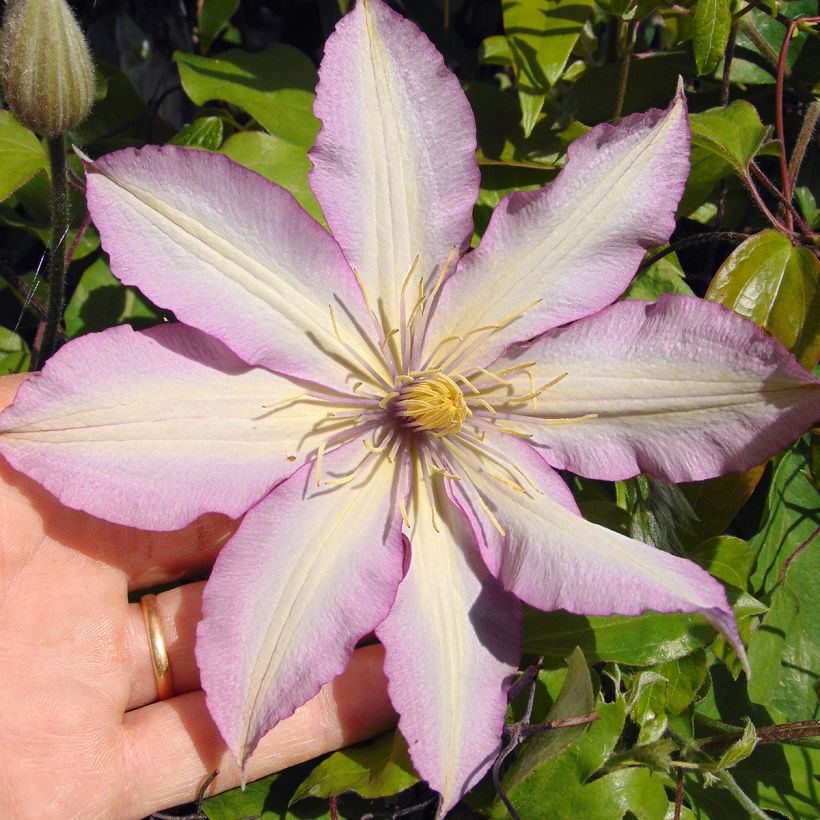



Plant habit
Flowering
Foliage
Botanical data
Clematis
patens
Morning Star
Ranunculaceae
Early Large-flowered Clematis
Cultivar or hybrid
Other Clematis A to Z
Planting and care
In a sunny location, shade the base of your plant with a ground cover or a perennial geranium. Clematis plants like to have their roots kept cool. Plant your clematis by covering the root ball with 5 to 10cm (2 to 4in) of soil, in soil that has been worked to a depth of 20cm (8in) and enriched with good compost. Water generously and regularly during the first few weeks. Clematis plants cling on their own thanks to their tendrils. To promote their growth, provide them with a trellis or help them dress the trunk of a tree by placing a wire mesh. Clematis plants also enjoy growing freely on neighbouring plants. You can prune it in June, to a height of 75cm (30in) if necessary.
Planting period
Intended location
Care
-
, onOrder confirmed
Reply from on Promesse de fleurs
Clematis
Haven't found what you were looking for?
Hardiness is the lowest winter temperature a plant can endure without suffering serious damage or even dying. However, hardiness is affected by location (a sheltered area, such as a patio), protection (winter cover) and soil type (hardiness is improved by well-drained soil).

Photo Sharing Terms & Conditions
In order to encourage gardeners to interact and share their experiences, Promesse de fleurs offers various media enabling content to be uploaded onto its Site - in particular via the ‘Photo sharing’ module.
The User agrees to refrain from:
- Posting any content that is illegal, prejudicial, insulting, racist, inciteful to hatred, revisionist, contrary to public decency, that infringes on privacy or on the privacy rights of third parties, in particular the publicity rights of persons and goods, intellectual property rights, or the right to privacy.
- Submitting content on behalf of a third party;
- Impersonate the identity of a third party and/or publish any personal information about a third party;
In general, the User undertakes to refrain from any unethical behaviour.
All Content (in particular text, comments, files, images, photos, videos, creative works, etc.), which may be subject to property or intellectual property rights, image or other private rights, shall remain the property of the User, subject to the limited rights granted by the terms of the licence granted by Promesse de fleurs as stated below. Users are at liberty to publish or not to publish such Content on the Site, notably via the ‘Photo Sharing’ facility, and accept that this Content shall be made public and freely accessible, notably on the Internet.
Users further acknowledge, undertake to have ,and guarantee that they hold all necessary rights and permissions to publish such material on the Site, in particular with regard to the legislation in force pertaining to any privacy, property, intellectual property, image, or contractual rights, or rights of any other nature. By publishing such Content on the Site, Users acknowledge accepting full liability as publishers of the Content within the meaning of the law, and grant Promesse de fleurs, free of charge, an inclusive, worldwide licence for the said Content for the entire duration of its publication, including all reproduction, representation, up/downloading, displaying, performing, transmission, and storage rights.
Users also grant permission for their name to be linked to the Content and accept that this link may not always be made available.
By engaging in posting material, Users consent to their Content becoming automatically accessible on the Internet, in particular on other sites and/or blogs and/or web pages of the Promesse de fleurs site, including in particular social pages and the Promesse de fleurs catalogue.
Users may secure the removal of entrusted content free of charge by issuing a simple request via our contact form.
The flowering period indicated on our website applies to countries and regions located in USDA zone 8 (France, the United Kingdom, Ireland, the Netherlands, etc.)
It will vary according to where you live:
- In zones 9 to 10 (Italy, Spain, Greece, etc.), flowering will occur about 2 to 4 weeks earlier.
- In zones 6 to 7 (Germany, Poland, Slovenia, and lower mountainous regions), flowering will be delayed by 2 to 3 weeks.
- In zone 5 (Central Europe, Scandinavia), blooming will be delayed by 3 to 5 weeks.
In temperate climates, pruning of spring-flowering shrubs (forsythia, spireas, etc.) should be done just after flowering.
Pruning of summer-flowering shrubs (Indian Lilac, Perovskia, etc.) can be done in winter or spring.
In cold regions as well as with frost-sensitive plants, avoid pruning too early when severe frosts may still occur.
The planting period indicated on our website applies to countries and regions located in USDA zone 8 (France, United Kingdom, Ireland, Netherlands).
It will vary according to where you live:
- In Mediterranean zones (Marseille, Madrid, Milan, etc.), autumn and winter are the best planting periods.
- In continental zones (Strasbourg, Munich, Vienna, etc.), delay planting by 2 to 3 weeks in spring and bring it forward by 2 to 4 weeks in autumn.
- In mountainous regions (the Alps, Pyrenees, Carpathians, etc.), it is best to plant in late spring (May-June) or late summer (August-September).
The harvesting period indicated on our website applies to countries and regions in USDA zone 8 (France, England, Ireland, the Netherlands).
In colder areas (Scandinavia, Poland, Austria...) fruit and vegetable harvests are likely to be delayed by 3-4 weeks.
In warmer areas (Italy, Spain, Greece, etc.), harvesting will probably take place earlier, depending on weather conditions.
The sowing periods indicated on our website apply to countries and regions within USDA Zone 8 (France, UK, Ireland, Netherlands).
In colder areas (Scandinavia, Poland, Austria...), delay any outdoor sowing by 3-4 weeks, or sow under glass.
In warmer climes (Italy, Spain, Greece, etc.), bring outdoor sowing forward by a few weeks.


































